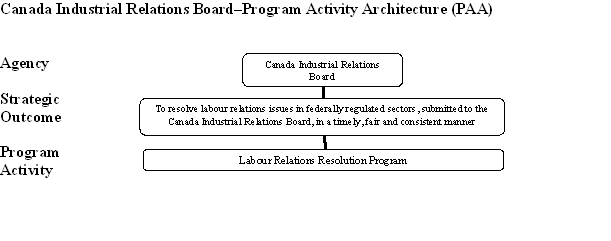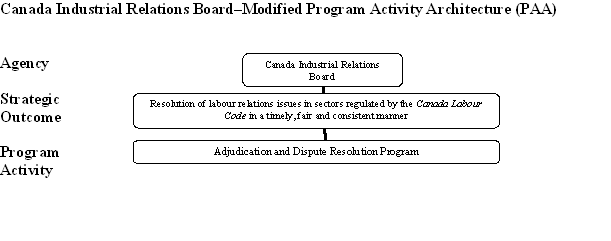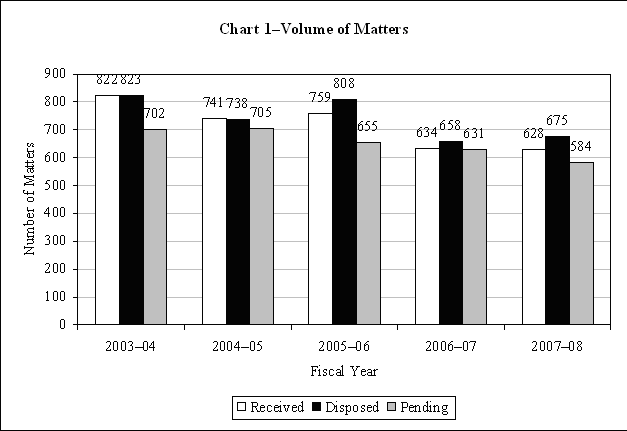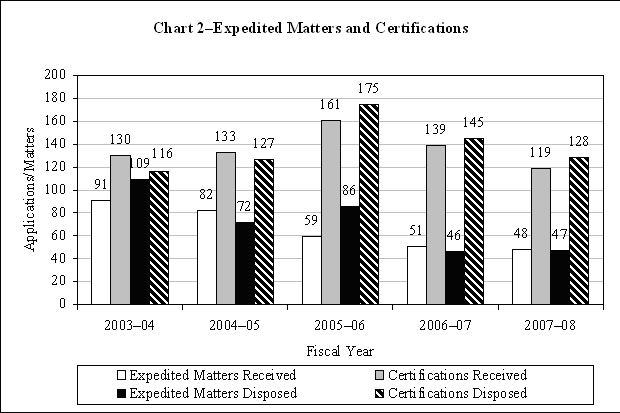Common menu bar links
Breadcrumb Trail
ARCHIVED - Canada Industrial Relations Board
 This page has been archived.
This page has been archived.
Archived Content
Information identified as archived on the Web is for reference, research or recordkeeping purposes. It has not been altered or updated after the date of archiving. Web pages that are archived on the Web are not subject to the Government of Canada Web Standards. As per the Communications Policy of the Government of Canada, you can request alternate formats on the "Contact Us" page.
SECTION I–OVERVIEW
1.1 Message from the Chairperson

I am pleased to present to Parliament and Canadians the tenth annual Performance Report of the Canada Industrial Relations Board (the CIRB or the Board), my first as Chairperson, for the period ending March 31, 2008.
The number of applications/complaints received by the Board decreased slightly in 2007–08 compared to the previous year, and remains significantly lower than the levels that prevailed in the 2000–01 to 2005–06 period. Alternatively, the number of matters disposed of by the Board also increased somewhat in 2007–08 over 2006–07 and, as a result, the number of backlog cases dropped to 584 as of March 31, 2008, the lowest level since 1997–98. Concerted efforts will be made during 2008–09 to further reduce this backlog.
The CIRB continued to refine the implementation of a number of initiatives in 2007–08 in order to improve its rate of matter disposition and meet the Board’s objective of reducing the level of pending matters and average processing time. However, the effect of these initiatives on the Board’s performance is somewhat concealed by the increased incidence of complex matters, that typically take much longer to process, and of long-standing duty of fair representation complaints which were resolved in 2007–08. Nevertheless, closer examination of case disposition trends show that these initiatives have had a positive impact on the Board’s underlying performance and, more importantly, should continue to have a positive effect in future years.
I am extremely pleased and proud of the accomplishments of the Board and its staff. We are, I believe, well positioned to improve on the fulfillment of our current mandate, and will continue to emphasize the reduction of both case processing time and the volume of pending matters. I would like to take this opportunity to thank the Board’s Vice-Chairpersons, Members and staff for their determination, and the dedication and support that they have provided me since my appointment.
Chairperson
1.2 Management Representation Statement
I submit, for tabling in Parliament, the 2007–08 Departmental Performance Report (DPR) for the Canada Industrial Relations Board.
This document has been prepared based on the reporting principles contained in the Guide for the Preparation of Part III of the 2007–08 Estimates: Reports on Plans and Priorities and Departmental Performance Reports:
- It adheres to the specific reporting requirements outlined in the Treasury Board Secretariat guidance;
- It is based on the department’s Strategic Outcome and Program Activity Architecture that were approved by the Treasury Board;
- It presents consistent, comprehensive, balanced and reliable information;
- It provides a basis of accountability for the results achieved with the resources and authorities entrusted to it; and
- It reports finances based on approved numbers from the Estimates and the Public Accounts of Canada in the DPR.
Chairperson
1.3 Program Activity Achitecture

Although the above PAA was in effect for the 2007–08 fiscal year, the CIRB recently made modifications, in consultation with the Treasury Board, to the wording of both its Strategic Outcome and Program Activity. The modifications are only meant to better describe the CIRB’s Strategic Outcome and Program Activity and do not reflect any underlying changes to them. The modified PAA is provided below.

1.4 Summary Information
Reason for Existence—The mandate of the CIRB is to contribute to and promote a harmonious industrial relations climate in the federally regulated sectors through the impartial, effective and appropriate administration of the rules of conduct that govern labour and management in their representational and bargaining activities. In achieving this strategic outcome, it provides effective industrial relations solutions for the Canadian labour relations community in a fair and timely manner.
Financial Resources (000’s)| Planned Spending | Total Authorities | Actual Spending |
| $12,437.0 | $13,301.3 | $12,516.1 |
Human Resources
| Planned | Actual | Difference |
| 110 | 101 | -9 |
Agency Priorities
| Initiative/Priority | Type | Performance Status |
| Accelerated reduction in the number of backlog cases | Ongoing | Progress made |
| Reduction of average case disposition time | Ongoing | Not met |
| Monitoring and fine-tuning of new certification application and disposition process | Ongoing | Progress made |
| Monitoring and fine-tuning of new duty of fair representation complaint and disposition process | Ongoing | Progress made |
| Review of reconsideration process | New | In progress |
| Stakeholder consultations | Ongoing | Progress made |
A more detailed account of each priority is provided in section 2.5 below.
1.5 Context and Background
The CIRB is an independent, representational, quasi-judicial tribunal responsible for the interpretation and application of the Canada Labour Code (the Code), Part I, Industrial Relations, and certain provisions of Part II, Occupational Health and Safety. It was established in January 1999, to replace the previous Canada Labour Relations Board (CLRB), through amendments to Part I of the Code.
As of March 31, 2008, the adjudicative team of the Board was composed of the Chairperson, five full-time and two part-time Vice-Chairpersons, and six full-time and two part-time Members—all of whom are Governor in Council (GIC) appointments. The Code requires that the Chairperson and Vice-Chairpersons must have experience and expertise in industrial relations, and that Members are to be appointed by the Minister of Labour, after consultation with the organizations representative of employees and employers.
The CIRB has jurisdiction in all provinces and territories with respect to federal works, undertakings or businesses in the following sectors:
- Broadcasting
- Chartered banks
- Postal services
- Airports and air transportation
- Shipping and navigation
- Inter-provincial or international transportation by road, railway, ferry or pipeline
- Telecommunications
- Grain handling and uranium mining and processing
- Most public and private sector activities in the Yukon, Nunavut and the Northwest Territories
- Band Councils and some First Nations undertakings
- Certain Crown corporations (including, among others, Atomic Energy of Canada Limited and certain national museums).
This jurisdiction covers some 800,000 employees and their employers, and includes enterprises that have an enormous economic, social and cultural impact on Canadians from coast to coast. The variety of activities conducted by the federally regulated sector, as well as its geographical scope and national significance, contribute to the uniqueness of the federal jurisdiction and the role of the Board, and pose particular challenges for the Board’s work.
The Board has established a series of strategic objectives in support of its mandate, which include:
- to seek solutions to labour relations problems by determining the cause and nature of conflict and by applying the appropriate dispute resolution mechanism, including fact finding, mediation and adjudication;
- to conduct its activities in a fair, timely and consistent manner;
- to consult its clients on its performance and on the development of policies and practices;
- to promote an understanding of its role, processes and jurisprudence through client contact and a variety of information dissemination methods; and
- to conduct its business and manage its resources in a manner that is fiscally sound, in accordance with the Financial Administration Act and the policies and directives of the central agencies of government.
1.6 Operating Environment
The Canadian labour relations environment has faced many challenges in recent years, and indications are that it will continue to do so in the foreseeable future. The globalization of markets, corporate mergers and restructuring, and the pace of technological change has resulted in heightened competition, and has led employers to seek productivity improvements, including the redefinition of bargaining units in some instances, in order to remain competitive. These pressures have increased in the last year with the strong appreciation of the Canadian dollar against its U.S. counterpart, the significant rise in the price of crude oil and concerns over the depth and breadth of a U.S. recession.
On the national front, although the labour market has been relatively tight, with unemployment rates at their lowest levels in thirty years, there has been an increasing number of announced lay offs and/or plant shutdowns that have led many economic forecasters to predict a rise in the unemployment rate in the coming year. Also, the impending retirement of a sizeable proportion of the workforce and the difficulty in finding qualified workers may put pressure on both sides of the bargaining table. Combined, these forces have, and will continue to have, an effect on Canadian employers, employees and the union-management relationship.
Those pressures are particularly evident in the federally regulated sector where the degree and rate of change has been largely unprecedented. Many of the industries, such as telecommunications and air transport to name but two, have gone from highly regulated monopolistic or semi-monopolistic structures to a form that is more unregulated and competitive. Also, many services that were once provided by the federal government, such as security and boarding at airports, have been commercialized. In particular, the phenomenal increase in the price of oil is adversely affecting the transportation industry, while the granting of new wireless spectrum by the Canadian Radio-television and Telecommunications Commission should result in new service providers and inject more competition in the wireless industry.
These profound changes associated with a workforce that is largely unionized have led to a situation where the Board is being increasingly called upon to resolve high profile and complex issues between bargaining parties, with substantial economic and social implications for the broader Canadian public.
Typical issues of continuing concern to the Board include:
- the acquisition and exercise of free collective bargaining rights, and the promotion of sound labour-management relations in a fair and transparent manner;
- the need to ensure that collective bargaining between employers and unions is conducted fairly and in good faith;
- the scope of the duty of fair representation in respect of minority groups of employees;
- the determination of the levels of services required to be maintained during a work stoppage to ensure the protection of the health and safety of the Canadian public;
- the prompt consideration of situations in which illegal work stoppages are alleged; and
- the need to assist companies and unions in resolving the labour relations implications of corporate mergers and take-overs-including the determination of bargaining unit structures and representation rights.
The complexity and implications of the issues facing federally regulated employers and unions require the Board to judiciously apply a wide range of knowledge and skills in diverse industrial relations, labour law and administrative law contexts. The stable economic environment over the past few years has been reflected in a modest decrease in cases coming before the Board, but current uncertainty is expected to produce increased demand for the Board’s services. Furthermore, the commitment of the Board to promote the joint resolution of issues by the parties, wherever possible, along with clients’ demands for the Board’s assistance in mediating unresolved issues as an alternative to litigation, entails increasing demands on the Board’s resources. Accordingly, the Board will continue to place emphasis on augmenting both its skill and resource levels to meet the needs of its clients.
After an initial spike in caseload levels in the years following the 1999 amendments to the Code, which widened the scope of matters that the CIRB could hear, the number of applications/complaints received has steadily declined over the last four fiscal years. In the first five years following the 1999 amendments to the Code, the CIRB received an average of 924 applications/complaints a year, compared to 691 over the last four years. The decline is even more apparent in the last two fiscal years (see Chart 1), as the number of incoming matters dropped to 634 in 2006–07 and 628 in 2007–08—the lowest level in the last twenty-five years.
The decline in the number of matters received over the last two fiscal years is essentially comparable across the various types of applications/complaints, although it was slightly larger for unfair labour practice (ULP) complaints other than duty of fair representation (DFR) complaints, applications for reconsideration and applications for an interim order. The decline was less pronounced for DFR complaints and applications for certification, and the number of maintenance of activity applications actually increased in 2007–08.
The reasons for the decline in the number of applications/complaints received by the Board are undoubtedly numerous, and would certainly include the solid jurisprudence that the Board has established since its inception. The Board has always maintained that the larger number of applications/complaints received in the years following the 1999 amendments to the Code were in part due to the lack of jurisprudence on the new Code provisions, since parties were more likely to litigate, given the uncertain interpretation of the new Code provisions. Another contributing factor in the recent decline of incoming matters is, until lately, the state of the economy and of the federally regulated sector. The Canadian economy has been doing quite well in the last few years, with a relatively robust rate of growth and the level of unemployment has dropped to a level that has not been seen for thirty or more years. At the federal level, the wave of major consolidations and restructuring of the early 2000s, particularly in air transport and telecommunications sectors, has subsided. This has translated to fewer frictions on the industrial relations front, which can be seen by a lower incidence of strikes and lockouts, by a trend to longer-term collective agreements and fewer applications/complaints to the Board.
This appears to be borne out by the CIRB’s statistics. ULP complaints, which represent approximately 40% of incoming matters in any given year, and are an indicator of the labour relations climate, are down by 27% on average in the last two fiscal years (representing 93 fewer complaints per year) compared to the previous five years. Excluding DFR complaints, which are complaints by union members against their union, and which are less sensitive to the state of the economy, the decline in ULP complaints would be much more pronounced at 47% (representing 80 fewer complaints per year).
With respect to the disposition of matters, the Board was able to improve its rate of matter disposition in the years following the 1999 amendments—it disposed of 855 matters per year on average over the five fiscal year period of 2001–02 to 2005–06 compared to an average of only 756 matters in the previous five fiscal years. However, similarly to incoming matters, the number of matters disposed of by the Board also declined in the last two fiscal years. In 2007–08 the Board disposed of 675 matters, only slightly higher than the 658 matters disposed of in 2006–07 (see Chart 1). The reasons for this decline are addressed below.
Nevertheless, given that the rate of disposition of matters outpaced the rate of incoming matters, the number of pending cases has steadily dropped, and stands at 584 cases as of March 31, 2008 (see Chart 1), the lowest level since 1997–98.
The CIRB’s workload and disposition rate continues to be largely affected by the greater incidence of more complex matters which typically involve lengthy hearings and numerous provisions of the Code. Such cases are both longer to process and require more of the Board’s resources for their disposition. Table 1 indicates that complex cases have generally accounted for 90 or more matters disposed of per year over the last five fiscal years, but have risen to 107 matters in 2007–08 or close to 16% of all disposed cases.
Table 1–Number of Complex Matters Disposed|
2003–04
|
2004–05
|
2005–06
|
2006–07
|
2007–08
|
|
| Review of bargaining unit structure |
17
|
21
|
19
|
9
|
18
|
| Single employer |
12
|
20
|
20
|
13
|
16
|
| Sale of business |
33
|
34
|
34
|
25
|
32
|
| Maintenance of activities |
28
|
19
|
23
|
16
|
41
|
| Total |
90
|
94
|
96
|
63
|
107
|
In addition to more complex cases, the Canada Industrial Relations Board Regulations, 2001 (the Regulations) stipulate that certain types of matters require priority attention. These cases include requests for an interim order/decision, requests to file Board orders in Court, referrals to the Board by the Minister of Labour relating to the maintenance of activities during a legal work stoppage, applications alleging an invalid strike or lockout vote, applications for a declaration of unlawful strike or lockout, and ULP complaints alleging the use of replacement workers or dismissal for union activities. Such matters are scheduled, heard and decided in priority to other elements in the Board’s caseload. Priority is also given to the processing and consideration of applications for certification, and to any other matter in which there appears to be a significant potential for adverse industrial relations consequences if there is a delay in its resolution.
The setting of priorities inevitably results in the deferral of less urgent matters. Scheduling pressures, consequent upon the volume and priority setting, can make very lengthy or complex matters—the kind of matters that are now typically scheduled for oral hearing by a panel of the Board—difficult to resolve expeditiously.
Chart 2 sets out the volume of expedited matters and certifications from 2003–04 to 2007–08.


